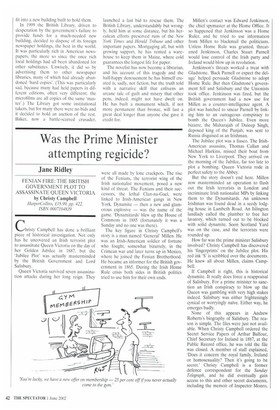Was the Prime Minister attempting regicide?
Jane Ridley
FENIAN FIRE: THE BRITISH GOVERNMENT PLOT TO ASSASSINATE QUEEN VICTORIA by Christy Campbell HarperCollins, £18.99, pp. 422, ISBN 0007104839 Christy Campbell has done a brilliant piece of historical investigation. Not only has he uncovered an Irish terrorist plot to assassinate Queen Victoria on the day of her Golden Jubilee in 1887, but the 'Jubilee Plot' was actually masterminded by the British Government and Lord Salisbury.
Queen Victoria survived seven assassination attacks during her long reign. They were all made by lone crackpots. The rise of the Fenians, the terrorist wing of the Irish nationalist movement, posed a new kind of threat. The Fenians and their successors, the lethal Clan-na-Gael, were linked to Irish-American gangs in New York. Dynamite — then a new and glamorous explosive — was the name of the game. `Dynamitards' blew up the House of Commons in 1885 (fortunately it was a Sunday and no one was there).
The key figure in Christy Campbell's story is a man named 'General' Millen. He was an Irish-American soldier of fortune who fought, somewhat bizarrely, in the Crimean war and later turns up in Mexico, where he joined the Fenian Brotherhood. He became an informer for the British government in 1865. During the Irish Home Rule crisis both sides in British politics tried to use him for their own ends. Millen's contact was Edward Jenkinson, the chief spymaster at the Home Office. It so happened that Jenkinson was a Home Ruler, and he tried to use information from Millen to blackmail the politicians. Unless Home Rule was granted, threatened Jenkinson, Charles Stuart Parnell would lose control of the Irish party and Ireland would blow up in revolution.
Jenkinson's threats worked a treat with Gladstone. 'Back Parnell or expect the deluge' helped persuade Gladstone to adopt Home Rule. But then Gladstone's government fell and Salisbury and the Unionists took office. Jenkinson was fired, but the British government had a new use for Millen as a counter-intelligence agent. A plot was hatched to smear Parnell by linking him to an outrageous conspiracy to bomb the Queen's Jubilee. Even more bizarre, the Maharajah of Duleep Singh, deposed king of the Punjab, was sent to Russia disguised as an Irishman.
The Jubilee plot was a fiasco. The IrishAmerican assassins, Thomas Callan and Michael Harkins, missed their boat from New York to Liverpool. They arrived on the morning of the Jubilee, far too late to plot a bombing. Queen Victoria rode in perfect safety to the Abbey.
But the story doesn't end here. Millen now masterminded an operation to flush out the Irish terrorists in London and incriminate Irish nationalist MPs by linking them to the Dynamitards. An unknown Irishman was found dead in a seedy lodging house in Lambeth Road. An Islington landlady called the plumber to free her lavatory, which turned out to be blocked with solid dynamite. Soon Scotland Yard was on the case, and the terrorists were rounded up.
How far was the prime minister Salisbury involved? Christy Campbell has discovered his 'fingerprints' on the Jubilee plot. His red ink 'S' is scribbled over the documents. He knew all about Millen, claims Campbell.
If Campbell is right, this is historical dynamite. It really does force a reappraisal of Salisbury. For a prime minister to sanction an Irish conspiracy to blow up the Queen was gambling with very high stakes indeed. Salisbury was either frighteningly cynical or worryingly naïve. Either way, he emerges badly.
None of this appears in Andrew Roberts's biography of Salisbury. The reason is simple. The files were just not available. When Christy Campbell ordered the Secret Service Papers of Arthur Balfour, Chief Secretary for Ireland in 1887, at the Public Record office, he was told the file was closed. A member of staff explained, 'Does it concern the royal family, Ireland or homosexuality? Then it's going to be secret.' Christy Campbell is a former defence correspondent for the Sunday Telegraph, and he did eventually gain access to this and other secret documents, including the memoir of Inspector Monro, head of the CID.
The book is written like a spy thriller, which was probably a mistake. At times the story is very hard to follow. I had to read a lot of it twice. And the thriller format allows no room for doubt or speculation, which there must surely be when the evidence is so fragmentary. But if Campbell is right, his story is sensational.







































































 Previous page
Previous page